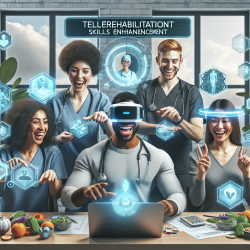Enhancing Your Telerehabilitation Skills: Key Competencies for Success

Telerehabilitation has revolutionized access to therapeutic services, especially in the wake of the COVID-19 pandemic. However, effective implementation of telerehabilitation programs requires a specific set of competencies from both health professionals and patients. A recent scoping review titled "Competencies required by patients and health professionals regarding telerehabilitation: A scoping review" sheds light on these essential skills.
Key Competencies for Telerehabilitation
The review identifies several competencies that are crucial for the successful use of telerehabilitation:
- Digital Literacy: Both health professionals and patients need to be proficient in using digital tools and platforms. This includes understanding how to navigate software, use video conferencing tools, and troubleshoot basic technical issues.
- Health Literacy: Users must be able to understand health information and apply it effectively. This is particularly important for patients who need to follow therapy protocols and manage their health conditions remotely.
- Communication Skills: Effective communication is key. Health professionals must be able to explain complex information clearly and empathetically, while patients need to be able to articulate their symptoms and concerns.
- Self-Management: Patients need to be able to manage their therapy routines independently, including setting up equipment, following therapy schedules, and performing exercises correctly.
- Technical Knowledge: Health professionals should have a thorough understanding of the technical aspects of the telerehabilitation tools they are using. This includes knowledge of data security and privacy regulations.
- Attitudinal Competencies: A positive attitude towards technology and a willingness to adapt to new methods are essential. Both health professionals and patients need to be open-minded and motivated to engage with telerehabilitation.
Implementing These Competencies
To implement these competencies effectively, health professionals can take the following steps:
- Training Programs: Participate in training programs that focus on digital literacy and technical skills. Many organizations offer online courses and webinars that can help you stay updated with the latest tools and techniques.
- Patient Education: Develop educational materials and resources to help patients understand how to use telerehabilitation tools effectively. This can include instructional videos, step-by-step guides, and troubleshooting tips.
- Continuous Learning: Stay informed about the latest research and advancements in telerehabilitation. Attend conferences, read relevant publications, and engage in professional networks to share knowledge and experiences.
- Feedback Mechanisms: Implement feedback mechanisms to understand the challenges faced by patients and health professionals. Use this feedback to refine and improve telerehabilitation programs.
Encouraging Further Research
While the scoping review provides valuable insights, it also highlights the need for further research in specific areas. For instance, the impact of sociodemographic factors on the successful use of telerehabilitation remains unclear. More research is needed to develop comprehensive competence frameworks that cater to diverse patient populations.To read the original research paper, please follow this link:
Competencies required by patients and health professionals regarding telerehabilitation: A scoping review.
Citation: Stark, A. L., Krayter, S., & Dockweiler, C. (2023). Competencies required by patients and health professionals regarding telerehabilitation: A scoping review. Digital Health, 9, 20552076231218841. https://doi.org/10.1177/20552076231218841










